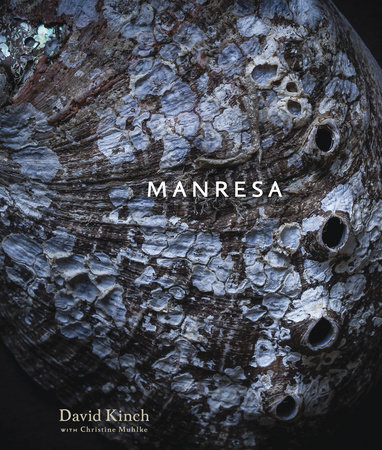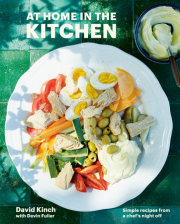Foreword While attending the Masters of Food and Wine festival in Carmel, California, over ten years ago, I heard talk of this incredible chef a couple hours north in Los Gatos. No one really knew of him or the restaurant; it was getting no consideration from the media, who were too focused on the Bay Area and Napa Valley. But from what I was hearing from those who had been, I knew I should eat there.
It was a long drive to Manresa, and I wasn’t fully convinced that I would have a great meal. When I arrived, I was surprised to be welcomed by a mature chef and not a young kid. I was immediately blown away by the meal—by the precision, the techniques, the creativity, by this “new” chef’s mastery. It was a long tasting menu, but I could have eaten ten more courses. I was in heaven.
Back in Carmel, I couldn’t stop talking about my meal and experience in Los Gatos. I was more than preoccupied by it, I was borderline obsessed. I needed to know more. I needed to know David. Over the following years, I took the journey back to Manresa several times. In 2004, I invited David to cook with me at a small lunch at Le Bernardin so he could (finally) meet a few key members of the press. My respect for him grew and our friendship began. Not only did I want to get to know David and his approach to cooking more, I wanted other people to know about him. And so in 2009, he kindly welcomed me and a small film crew into his world while we tried to capture some of the essence of his philosophy for a TV project I was working on. David brought me surfing in Santa Cruz and gardening at Love Apple Farms. He invited me into his restaurant, his garden, his world. I learned of his methods and style and also of his determination to achieve perfection.
What I admire most about David is his sense of humility and curiosity. He has created a very personal style of cooking without losing his connection to the seasons or to the region that beautifully surrounds his restaurant. I admire his ability to evolve, and today he is one of the pioneers of the locavore and farm-to-table movement in America as it reaches even higher levels. The desire to cook only with fresh produce and the best ingredients available is in his DNA, and nothing highlights this more than his work with Love Apple Farms. What is harvested there completely dictates Manresa’s menu. You can’t dedicate your work more to nature than that. David is more connected to nature than anyone I know. Every ounce of his energy and creativity pays homage to the bounty of his surroundings in one of the most exquisite areas of California. Each item and dish component on the menu speaks to who David is and what he is about. He is a chef, a gardener, and a surfer. He is organic, biodynamic, and sustainable. He is honest and conscientious. He is creative and committed. He is an inspirational peer and has become a great friend. The fruit of David’s work is a true gift to the industry, for which we can all be grateful.
Eric RipertINTRODUCTION Manresa opened in Los Gatos, California, in 2002. I thought of it as the grown-up relocation of Sent Sovi, the restaurant I’d run for seven years in nearby Saratoga, where I served California bistro food: local ingredients, simply prepared. Sent Sovi was successful from Day One. But after almost a decade of operating on a shoestring budget and spinning around in an old kitchen the size of a closet, I wanted to find a space where I could finally realize my potential to cook the haute cuisine in which I’d trained and aspired to make at the time. So I was thinking about my next move and lining up investors. And then, one night in 1998, I had dinner at the French Laundry.
Stupefied by the incredible food and wine that evening, I accidentally left my wine bag under the table. I went back to find it at nine o’clock the next morning. Thomas Keller was there alone, putting up stocks. I didn’t know him very well, but he sat down and asked if I wanted a coffee. He asked what I was doing. I told him about Sent Sovi, adding that I was thinking of moving to a bigger place.
“Can I give you some advice?” he said. I thought, of course you can, Sir Thomas...He continued, “If you have the opportunity, buy it.” He’d purchased the French Laundry and the surrounding buildings—a deal that countless California chefs had turned down, unable to make the numbers work for such a small restaurant.
“But that’s a lot of money,” I said.
“Of course it is. But if you buy it, you’ll be able to retire. You will be a slave to your restaurant for twenty years, but look at what we do: It’s a good thing to be wedded to the site because it prevents you from walking away. Plus, you’ll attract a different quality of investor. You’ll attract people who realize that it’s really a real-estate deal where a restaurant happens to be taking place.”
So I scrapped my business plan and changed tack: I would buy a place and set down roots.
A chance to move to San Francisco, sixty miles north, fell through at the last minute. But then I stumbled upon a vacant building for sale six miles down the road from Sent Sovi in Los Gatos, another charmingly quaint Silicon Valley bedroom community tucked into the foothills of the Santa Cruz Mountains.
Hidden downtown behind a little rabbit warren of one-way streets and bank parking lots, the Village House had been a restaurant and event space until it was left to rot about fifteen years before. I felt an immense attraction to the ramshackle ranch house, which I hadn’t felt at the last three dozen places I had explored. The roof had holes in it. The interior was gutted. Inside, the remaining four walls had been spray-painted with stoner graffiti by kids. It was a blank canvas in what was, for me at least, an ideal location. I saw that with some immediate improvements, I’d be able to create my version of the small, personal restaurants that had so profoundly changed me when I was a chef in my early twenties, apprenticing and traveling in France, Spain, and Germany. (Hint: they weren’t the ones with long, tree-lined driveways and
Relais & Châteaux plaques next to the doors.)
During those years in the early 1980s, I saved all of my money to dine at my heroes’ restaurants—Paul Bocuse, Maison Pic, and the great Alain Chapel—and as many great country restaurants as I could. They were places off the beaten track. Going there was a journey, the place a destination. I’d slip down a side street and walk around looking for the address. Is it here? Did I pass it already? The entryway was typically understated, and as soon as I crossed the threshold, it was like entering someone’s grand yet intimate home (and sometimes I was). These restaurants were the creations of people who had a vision and worked hard to achieve it, creating lasting memories of comfort, welcoming service, impeccable food, and good wine.
What stayed with me most was how each restaurant spoke not only of those who ran the house but also of where it was: Each was unique to its location, like the five-house town of Mionnay, which I drove into and out of several times while trying to find Alain Chapel. (Finally, one of the old men playing boules across the street from the restaurant helped me.) After I’d eaten at a few of these establishments, it dawned on me that even if the town was unremarkable, the environment added an important context to the meal. It was the first time I had experienced what later came to be known as “sense of place,” and it was an incredible awakening. During those years at Sent Sovi, it was always in the back of my mind.
Sent Sovi was where I fell in love with the act and process of cooking, and where I began to understand how it could affect people—much like I’d been moved in Europe. I loved the creativity of the kitchen, learning from successes and failures, working with fire and realizing my whole life was spent learning to control it. Mostly I loved the pleasure and happiness that I could give to others, as well as to myself. Sent Sovi provided me with a great opportunity to get to know California’s ingredients, but I was ready to go deeper into technique, which I just couldn’t do in such a casual restaurant. I was finally ready to create the experience of a specific place through cooking at a high level in a space that would feel like my home.
Once I looked past that shell of a building—tucked into a corner of Los Gatos like the town itself was tucked into a corner of the Santa Cruz Mountains—I saw its potential to become such a restaurant. Here was my chance. If I could build it as I imagined it, would people drive even from San Francisco to dine there, like I’d once sought out restaurants in the European countryside? I couldn’t wait to find out.
Green Garlic Panisse
Makes about one hundred 1 1/4 by 2-inch pieces
A simple snack that takes advantage of the season’s first garlic, which is harvested before the bulbs form. Delicious hot or cold.
250 grams (9 ounces) white portion of green garlic
100 grams (7 tablespoons) butter
100 grams (7 1/2 tablespoons) extra-virgin olive oil
1.9 kilograms (8 cups) whole milk
45 grams (3 tablespoons) kosher salt
475 grams (3 1/2 cups) sifted chickpea flour
1 Meyer lemon
Grapeseed oil, for deep frying
Line a half sheet pan (13 by 18 by 1-inch pan) with oiled parchment paper.
Split the garlic lengthwise and rinse carefully to remove any dirt. Dry the garlic on a towel, then slice it as thinly as possible. Melt the butter with the olive oil, add the garlic, cover with a cartouche (see page 310), and cook over low heat until translucent.
Transfer to a large pot and add the milk and salt. Increase the heat to medium-high and slowly add the chickpea flour while whisking constantly to avoid lumps. Cook over high heat until the mixture begins pulling away from the sides of the pan and the starchy flavor has cooked out. Pour the dough onto the prepared pan and spread evenly. Zest the lemon over the entire surface. Place plastic wrap directly on top of the panisse to prevent a skin from forming. Refrigerate for about 1 hour, until completely set. Cut into desired shapes.
Heat the grapeseed oil to 350°F (175°C) and fry the panisse pieces in small batches for about 30 seconds, until golden brown and crispy. Drain on paper towels, arrange on a platter, and serve immediately.
Copyright © 2013 by David Kinch with Christine Muhlke; foreword by Eric Ripert. All rights reserved. No part of this excerpt may be reproduced or reprinted without permission in writing from the publisher.









